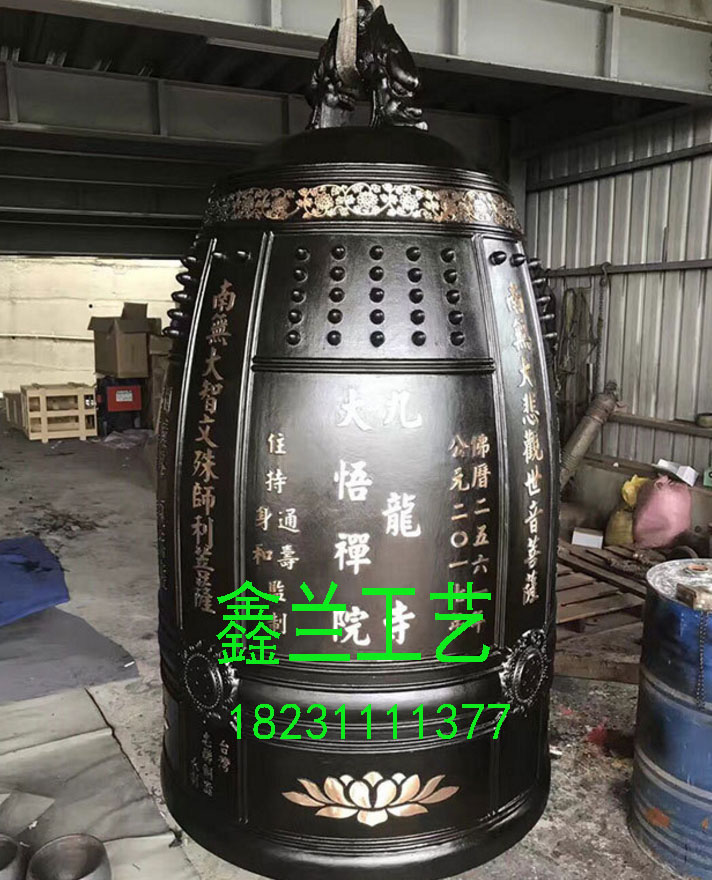清代的宦官在退养之后和明代的宦官一样,修养在寺庙之中,而北京的寺庙多修建于明代,钟作为佛事中重要的法器,由于其体积较大,材质为铜、铁,可以长期使用。所以到了清代出现了保留前朝用钟并对其重新修铸的现象。例如:乾隆乙亥重修宏慈道院募天顺丁丑铜钟,该钟的钟钮是在乾隆时期被重修过。
Eunuchs in the Qing Dynasty, like eunuchs in the Ming Dynasty, were cultivated in temples. Most of the temples in Beijing were built in the Ming Dynasty. As an important instrument in Buddhist affairs, bells can be used for a long time because of their large size and copper and iron materials. So in the Qing Dynasty, zhengqifa.89ix.com mojusugmj.37ix.com.cn mojugg.37ix.com.cnhulan.37ix.com.cn jueyuanjian.37ix.com.cnxingtai.71ix.cnthere appeared the phenomenon of retaining the bells of the former dynasty and recasting them. For example, in the reinvention of the bronze bell of Hongci Daoist Court in Qianlong and Yihai, the button of the bell was repaired during the reinvention of Qianlong
铜钟是一种乐器:古代祭祀或宴飨用乐器古属八音金类 二、铜钟也是王权象征:钟鼎统治阶级王权象征钟鸣鼎食权势位标志 三、佛教器:铜钟发音宏亮悠扬自佛教传入始铜钟逐渐佛教寺院缺少器--佛钟@_@古代祭祀或宴飨时用的乐器。由王孙钟上的铭文:“用享以孝,于我显祖文考。……用宴以喜,用乐嘉宾父兄,及我朋友”,可以证明钟是宗庙及宴会时的乐器。在历代所铸的钟里,间或有铁铸的,但绝大多数还是铜铸钟。早在原始社会,作为礼器的钟就出现了。明代科学家宋应星在《天工开物》里写道:“梵宫仙殿,必用以明×(手+耳 打动之意)谒者之诚,幽起鬼神之敬。当暮霭渐合,寺院庙堂钟声回荡,木鱼橐橐,与僧尼颁经声溶为一钵,增添了莲花佛界特有的神秘气氛。悬挂编钟,有严格的礼乐制度规定:天子宫悬(四面悬钟)、诸侯轩悬(三面悬钟)卿大夫判悬(两面悬钟)、士特悬(一面悬钟)。伟大的爱国诗人屈原“黄钟毁弃,瓦釜雷鸣”的著名诗句,就是这种象征的反映。明代永乐年间铸造巨型铜钟,重量达数十顿,无论是铸造工艺还是体积重量,都达到了登峰造极的地步。
The bronze bell is a kind of musical instrument: ancient sacrificial or banquet instruments belong to eight tones golden class II, bronze bell is also a symbol of Royal power: the ruling class of the bell rings, the symbol of power and position of eating the tripod; Buddhist instruments: bronze bell pronunciation is magnificent and melodious since the introduction of Buddhism, bronze bell gradually lacks instruments in Buddhist monasteries - Buddhist bell @ used in ancient sacrifices or banquets. The inscription on Wang Sun-zhong: "Enjoy filial piety and show my ancestors to me... It can be proved that the bell is the musical instrument of the temple and the banquet. In the bells cast in the past dynasties, there were occasional iron ones, but most of them were copper ones. As early as the primitive society, the bell as a ritual appeared. Song Yingxing, a scientist in the Ming Dynasty, wrote in Tiangong Kaiwu: "The Vatican zhuguangzhi.37ix.com.cnjinyinzhi.37ix.com.cnsekazhi.37ix.com.cn tongfengg.37ix.com.cnshusongdaih.07858.netshusongdaif.07858.netPalace Celestial Palace must use the sincerity of the orators to raise the reverence of ghosts and gods. When the twilight converged, the bells of temples and temples echoed, and the wooden fish were simmering, which melted into a bowl with the sound of monks and nuns giving scriptures, adding a unique mysterious atmosphere to the Lotus Buddhist world. There are strict rules of etiquette and music for hanging bells: Tian uterus hanging (four sides hanging bell), Zhu Xuan hanging (three sides hanging bell), Qing doctor hanging (two sides hanging bell), and Stephen hanging (one side hanging bell). The famous poem of the great patriotic poet Quyuan, "Huang Zhong abandoned, Wa Ke thundering" is a reflection of this symbol. In Yongle period of Ming Dynasty, the huge copper bell, which weighed tens of tons, reached the peak of its height in both casting technology and volume weight.

